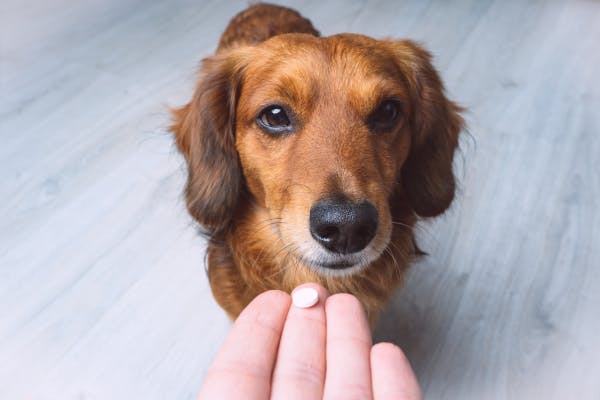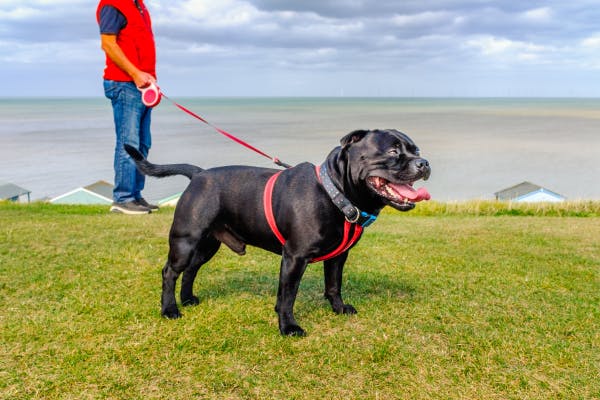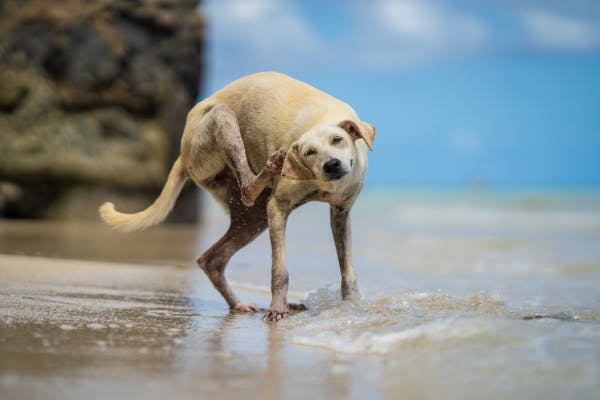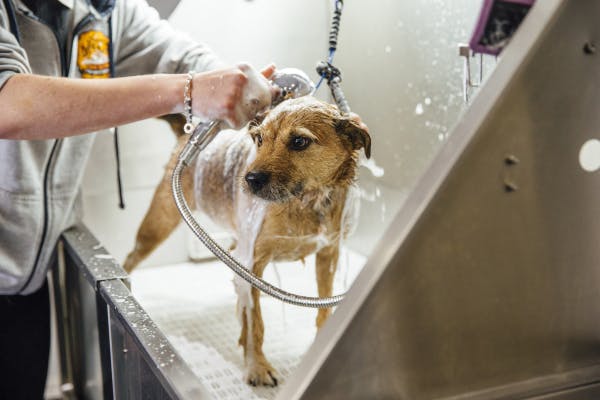learn about flea collar for dogs
Good and Bad of Dog Flea Collars: Chemical or Natural Collar?
Learn how well dog flea collars work, if they're safe, and other choices. Understand how they operate and what they're made of, and the right way to use them.
Learning About Flea Collars for Dogs: Their Purpose and Function
Flea collars for dogs are a well-known tool used by dog owners to shield their pets from the discomfort and possible health problems caused by fleas. These collars are made to push away or kill fleas, creating an effective defense against these annoying bugs.
What is a Flea Collar?
A flea collar is a kind of collar that dogs wear. It is made to keep fleas away. The collar has chemicals in it that push away or kill fleas, keeping the dog who wears it safe.
How Do Flea Collars Work?
Flea collars work in two main ways:
Pushing Away Fleas: Some flea collars work by letting out a gas or chemicals that push fleas away. This means that fleas are kept from even getting close to your dog, not to mention biting them.
Killing Fleas: Other flea collars work by letting out chemicals that kill fleas when they touch them. This means if a flea does get onto your dog and bite them, they will be killed before they can cause any harm.
It's key to know that some flea collars only do one of these jobs, while others do both. When picking a flea collar, it's very important to know what kind of protection your dog needs and pick based on that.
Flea collars usually work for several months at once, making them an easy choice for long-term control of fleas.
Why Use a Flea Collar?
There are several reasons why dog owners might choose to use a flea collar:
Long-lasting Protection: Most flea collars protect against fleas for several months at once.
Easy to Use: Once the collar is on your dog, you don't have to worry about giving treatments often.
Saves Money: Usually, flea collars cost less than other kinds of flea treatments over time.
But it's key to remember that every dog is different. What works well for one might not work as well for another. Always talk with your vet before deciding on the best way to control fleas for your pet.
The Importance of Using Flea Collars Correctly
To make sure the collar works well and keeps your pet safe, it's very important to use the collar right:
Make sure the collar fits right: It should be tight enough so it doesn't fall off but loose enough so it doesn't choke your pet.
Check often: Regularly check how the collar looks and replace it when needed.
Watch your pet: Keep an eye on your pet after you've put on the new collar. If they show signs of discomfort or bad reactions like skin irritation or changes in behavior, take off the collar right away and talk with your vet.
While there are many ways available for controlling fleas in dogs, flea collars stay an effective and easy choice when used right. Always talk with your vet before picking any kind of treatment plan for your pet!
What's Inside Flea Collars: The Stuff That Fights Fleas
Flea collars are a common pick for pet owners who want to keep their pets safe from annoying fleas. These collars do their job by letting out active ingredients that either scare away or kill fleas. The material of the collar acts like a storage tank, slowly letting these substances touch the pet's skin and fur.
Here are some usual active ingredients found in flea collars:
Deltamethrin: This is a man-made version of a natural pesticide called Pyrethrin, which was discovered in the juice of chrysanthemum flowers over a hundred years ago. Deltamethrin is seen as one of the safer bug killers and it works by quickly making the nervous system of fleas stop working.
Amitraz: This ingredient is often found in flea collar products and is known to be a good drug against parasites. But, scientists still don't know much about how Amitraz works.
Pyriproxifen: This ingredient goes after flea eggs and baby fleas, basically making pests sterile by stopping them from growing up and having babies.
Propoxur: Propoxur also makes the nervous system of fleas stop working quickly. Within 24 hours of putting it on, bugs will just die on your pet's body. But, this ingredient can be very poisonous to humans, so it's important to wash your hands after touching collars with Propoxur.
While these ingredients can effectively scare away or kill fleas, they might not be good for all pets or situations. For example, bigger dogs might need stronger collars while puppies need collars that are okay for their soft skin.
Besides picking the right active ingredients for your pet's needs, you should also think about other things like your pet's size, age, breed, and where they live when picking a flea collar.
Subscribe to our newsletter an never miss a deal or our weekly product reviews again!
How Well Do Flea Collars Work? What Science Says
Science says that new flea collars can work very well. For example, a study by the School of Veterinary Medicine at Purdue University found that some flea collars could kill up to 95% of fleas on your dog in the first few days of use.
But, how well flea collars work can change based on several things:
Kind of Collar: Different brands and kinds of flea collars may use different ingredients, which can change how well they work.
Dog's Size: Bigger dogs might need stronger collars, while puppies need collars that are safe for their soft skin.
Dog's Breed: Some breeds may have thicker fur, making it harder for the collar to touch the fleas.
Where You Live: How many fleas are in your home or yard can also change how well the collar works.
Science has also found differences in how well natural and chemical flea collars work. Natural collars use things like essential oils to push pests away and are usually safer but might not work as well as chemical-based collars if there are a lot of fleas.
Studies have also looked at if flea collars are safe. While they are usually safe to use, some dogs might get side effects like skin problems, redness, or swelling around the neck area.
So, science says that while flea collars can be a good way to control and stop flea problems in dogs, how well they work can change based on several things including the kind of collar used, the size and breed of your dog, and where you live. It's always important to watch your pet for any bad reactions when using these products and talk with a vet if needed.
Be Careful When Using Flea Collars for Dogs
Possible Dangers
Flea collars have chemicals in them that kill fleas. These chemicals can be dangerous if a person or pet swallows them or if they get on the skin. Some flea collars might have things like amitraz and propoxur in them. These can be very harmful to dogs if they swallow them. If your dog swallows a collar by accident, it can get very sick.
The stuff in flea collars can also leave a leftover on your dog's fur that stays for many weeks. This leftover can be bad if swallowed, either by your dog licking its fur or by other pets or kids touching the dog and then putting their fingers in their mouths.
Steps to Take
To make these dangers smaller, you should take certain steps when using flea collars:
Always read the directions carefully before using a flea collar and do what any safety rules say.
Clean your hands well after touching a flea collar.
Make sure the collar is on right so that your pet cannot easily take it off.
Don't let kids touch the collar.
Watch your pet for any signs of not feeling well or bad reactions after putting on the collar.
If your pet swallows the collar by accident or if you see any signs of poisoning like not being able to move right or throwing up, take off the collar right away and get help from a vet.
Other Choices
If you don't feel good about using flea collars, there are other ways to stop fleas:
Natural choices: Some changes in food and natural treatments might help keep fleas away naturally.
Chemical treatments: Spot-on treatments, pills you swallow, shampoos, dips etc., can also work well at stopping fleas.
Always talk with your vet before picking a way to make sure it's safe and good for what your pet needs.
While flea collars can work well at stopping fleas on dogs, they need to be used carefully because of possible dangers that come with using them. By taking the right steps and watching your pet closely after putting it on, you can help make sure your pet stays safe while getting protection against fleas from these products.
Natural and Chemical Flea Collars: Good and Bad Points
Protecting a dog from fleas can be done using a flea collar. But there's a choice to make: pick a natural or chemical flea collar? Let's look at the good and bad points of each.
Natural Flea Collars
Natural flea collars use things from nature, like essential oils, to keep fleas away.
Good Points of Natural Flea Collars
Safety: These collars use natural things, so they are less likely to cause bad reactions or health problems for both dogs and humans.
Good for the Environment: Natural flea collars are less bad for the environment than chemical ones.
No Chemical Leftovers: These collars don't leave any chemical leftovers on the dog's fur or in your home.
Bad Points of Natural Flea Collars
Not as Good at Killing Fleas: While natural flea collars can keep fleas away, they may not be as good at killing fleas that are already there.
Don't Last as Long: These collars often need to be changed more often than chemical ones because they don't work as long.
Strong Smell: Some dogs (and people) might think the smell of essential oils used in these collars is too strong.
Chemical Flea Collars
Chemical flea collars use bug killers that kill or keep fleas away.
Good Points of Chemical Flea Collars
Very Good at Killing Fleas: These types of collars are usually very good at not only keeping away but also killing fleas and ticks.
Lasts a Long Time: A single chemical collar can protect for several months, making them easy for pet owners.
Bad Points of Chemical Flea Collars
Can Cause Health Problems: The chemicals used in these products could cause side effects like skin problems, throwing up, and even brain issues in some dogs.
Bad for the Environment: The chemicals can also be bad for the environment.
Risk to Humans and Other Pets: There's a chance that children or other pets could touch the chemicals if they touch the collar.
Both natural and chemical flea collars have their good points and bad points. When picking between them, it's important to think about things like your dog's health, lifestyle, and what you think about natural versus man-made products. Always talk with a vet before making any choices about your pet's health care plan.






